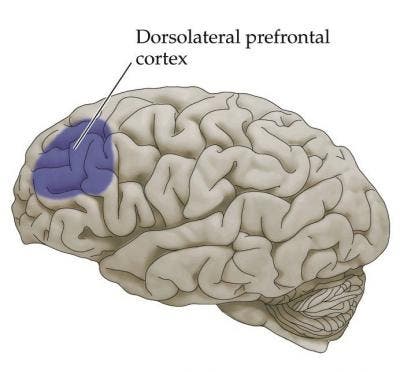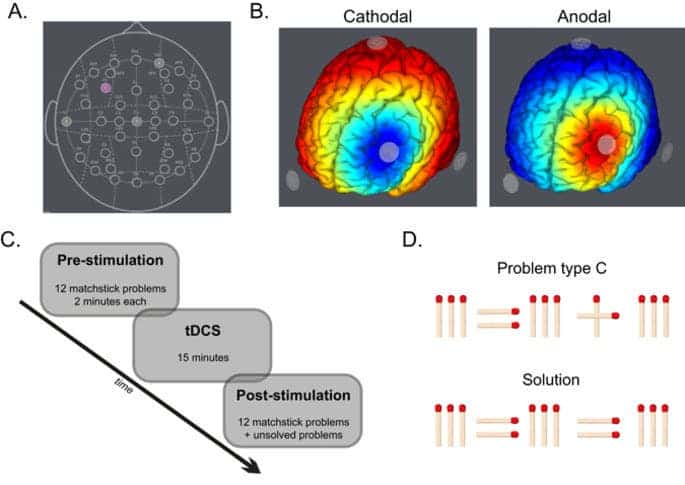When scientists suppressed a region in the brain involved in planning and reasoning with electrical current, the volunteers’ ability to think in more creative ways was significantly enhanced. Doc Brown from Back to the Future was actually on to something all along. The drawback, however, was that this came at the cost of sacrificing working memory which is useful for other tasks.

Thinking outside the box
In 2011, Australian researchers reported how their study participants became three times more likely to complete puzzles than the control group after having their brain stimulated by small amounts of electricity. The technique is called transcranial direct current stimulation (tDCS) and involves sending apparently harmless, minuscule currents across the brain through conductive pads placed on the skull. This is an extremely powerful method that can be used to shape mood, learn faster, or even brain-to-brain communication. But in the aftermath of the 2011 study, it was never clear whether positive or negative stimulation — excitement or suppression — was what triggered the effect.
To get to the bottom of things, a team at Queen Mary University of London enlisted 60 volunteers who were tasked with completing various on-screen computer puzzles. The puzzles, which might be familiar to some of you, involve moving matchsticks around to produce solvable equations. For instance, in one problem the participants had to solve:
IV = III + III, whose solution is moving the leftmost I to the right to produce VI = III + III.
There were four types of puzzles, from simple to hard. The hardest puzzles required the volunteers to seriously think outside the box and shed preconceived ideas and notions. For instance:
In III = III + III, participants had to move one of the two matchsticks that form the + sign to make an = sign like so: III = III = III.
There were 12 such problems in all and after the participants finished their attempts, they were separated into three groups. One group had electrical activity briefly switched on and off, followed by 15 minutes of no stimulation; this was supposed to be the control or ‘sham’ setup. The other two groups received either a positive or negative stimulation to the left side of a region of the brain known as the dorsolateral prefrontal cortex (dlPFC).

The dlIPFC serves a highly important executive role within the brain and subsequently, is the main site of cognitive control in both humans and monkeys. It is heavily interconnected with a variety of other cortical brain regions, sending and receiving inputs to and from most sensory brain regions, as well as subcortical brain regions like the basal ganglia. Working memory is also known to be dependent on the dlPFC.
After having the dlPFC stimulated or suppressed, participants had to tackle yet a new set of 12 puzzles. Those who had their dlPFCs suppressed were more likely to solve the toughest puzzles for the first time than the participants who received anodal or sham tDCS. Six times more people who had suppressed dlPFCs completed the puzzles compared to those that received a sham zap to the brain.

It’s thought that suppressing the dlPLFC freshens the brain by stimulating people to forgo experience when approaching a new task. For instance, mathematical thinking and rules can become deeply entrenched once established, typically when we’re school children, which is why it’s considered so difficult for people to think about turning a + sign into an = one.
“We solve problems by applying rules we learn from experience, and the DLPFC plays a key role in automating this process,” commented Dr Caroline Di Bernardi Luft, first author of the new study published in Scientific Reports, in a statement.
At the same time, however, suppression of this critical brain region caused poor performance in other matchstick puzzles that heavily relied on working memory. Win some, lose some.
These findings suggest that it’s possible — and indeed foreseeable — that sometime in the future people might employ devices based on transcranial direct current stimulation to augment their creativity. It wouldn’t be all that different from how some people already turn to alcohol or drugs for inspiration. And it might work too — as long as the task at hand doesn’t involve things like remembering phone numbers. Luft, however, cautions we’re still pretty far from seeing this happening despite what some companies might already market.
“These results are important because they show the potential of improving mental functions relevant for creativity by non-invasive brain stimulation methods,” commented Dr Luft.
“However, our results also suggest that potential applications of this technique will have to consider the target cognitive effects in more detail rather than just assuming tDCS can improve cognition as claimed by some companies which are starting to sell tDCS machines for home users,” she added.
“I would say that we are not yet in a position to wear an electrical hat and start stimulating our brain hoping for a blanket cognitive gain.”






